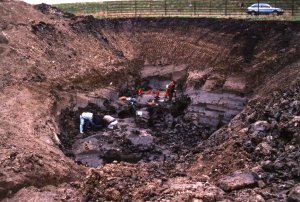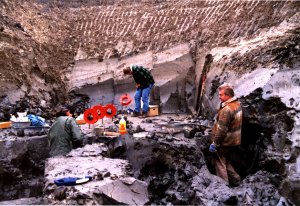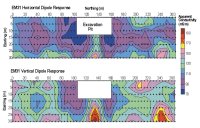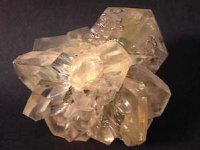Gypsum Rosettes Project
By Nancy Chow, Ian Ferguson and Jeff Young,
Dept. of Geological Sciences, University of Manitoba
Winnipeg, Manitoba
Each spring, Winnipeggers appreciate the importance of the Red River floodway as it diverts floodwaters around the city. However, unbeknownst to most, "Duff's Ditch" provides access to gypsum rosettes that are highly prized by mineral collectors (Figure 1). Students and staff in the Dept. of Geological Sciences at the University of Manitoba, with assistance from students and teachers at Glenlawn Collegiate and Sisler High School in Winnipeg (Figure 2), have undertaken a multi-disciplinary project to characterize the gypsum rosettes and their distribution.
Concentrations of gypsum rosettes were first noted in Lake Agassiz clays along the Red River floodway during its construction in 1959 to 1968, and to date "ore-grade" gypsum rosettes have been commercially exploited at two locations along the banks of the floodway. The rosettes, cm to tens of cm in size, vary from compact balls of radiating, amber-coloured small blades to spectacular "starbursts", of yellow to colourless, large blocky crystals (see Figure 1). In 1997 and 1998, AMA Mines and associates excavated two large pits along the banks of the Red River floodway near the TransCanada Highway to extract gypsum rosettes. This commercial operation has enabled Geological Sciences staff to initiate a multi-disciplinary project to characterize the gypsum rosettes and their distribution. The preliminary results were presented at the Manitoba Mining and Minerals Convention in November 1998. Additional work this spring and summer has included investigations of gypsum crystal occurrences in other sites in southern Manitoba.

Figure 2. Overview of excavation pit in Red River floodway, showing students from Glenlawn Collegiate and commercial mineral collectors at work.

Figure 3. Small-scale DC-resistivity survey being done in the pit to determine the conductivity of the clay unit.
Geology
The primary objective of the geological component of this project is to investigate the formation of the gypsum rosettes by:
- characterizing the colour and morphology of the rosettes relative to their stratigraphic and lateral distribution within the excavation pits.
- investigating the zoning within gypsum crystals using petrographic and geochemical analyses (Figure 4).
- investigating the grain size, mineralogy and chemical composition of the host clays.
| |

Figure 4. Thin-section photomicrograph of the termination of a gypsum crystal under blue-violet epi-fluorescence (photo by David McDonald). The crystal exhibits a dark blue core and a light blue green rim, the cause of which is yet to be determined.

Figure 5. Terrain conductivity (EM31) mapping of the excavation pit area. The horizontal-and vertical dipole responses indicate the average electrical conductivity in the upper 2.5 m and 5 m respectively. The maps show a conductive zone near the pit. This zone is located within clay units overlying those hosting the rosettes. Photo by Virginia Maris. View large image (130k).
|
Petrographic and geochemical data provide further insight into pore-water evolution in Lake Agassiz clays, complementing previous studies on pore-water geochemistry and geohydrology of these clays. David McDonald has just completed his Honours thesis on gypsum rosettes from the 1998 excavation pit, under the supervision of Nancy Chow and Jeff Young. Dave Benson, a second-year Honours student, has been awarded an NSERC Undergraduate Student Research Award to do a petrographic study of gypsum crystals from selected sites in southern Manitoba, as well as geophysical surveys of these sites. Gaywood Matile, Manitoba Energy and Mines, has provided valuable assistance in examining these sites.
Geophysics
The objectives of the geophysical component of this project are to:
- investigate the geophysical response of the clays hosting concentrations of gypsum rosettes.
- investigate the geophysical response of related features in the surficial deposits including the thickness of the surface silt layer, depth to carbonate bedrock, presence of iceberg scours, and the response, if any, of fractures in the clays.
- use the information obtained to develop exploration methods for finding new, "ore-grade" concentrations of gypsum rosettes.
Geophysical measurements include seismic refraction, DC-resistivity and electromagnetic induction (TEM and EM31) (Figure 3 and 5). Virginia Maris, an M.Sc. Geophysics student, and Ian Ferguson, with the involvement of about ten high school students, have conducted the geophysical work as part of the Advanced Applied Geophysics graduate course. Additional surveys were done by undergraduate students taking the Geophysics Field School and by Dave Benson and other students this spring and summer.
Public Awareness
An important aspect of this project is public awareness. Jeff Young has introduced students and teachers at Glenlawn Collegiate and Sisler High School to field work in the pits along the floodway and to laboratory studies where the students have hands-on exposure to analytical techniques, such as microscopy, x-ray diffraction, the electron microprobe and scanning electron microscope. This work is now funded by a University of Manitoba major outreach grant for 1999.
As a result of this outreach, high school students have an increased appreciation of science and its applications in understanding the Earth. The scope of current high school curricula in the physical sciences (i.e. chemistry and physics) has been broadened. Under school-developed concepts of outcomes and advocacy, the project has helped to facilitate the science education of motivated students, allowing students to work with and accept others, show a commitment to life-long learning, and demonstrate problem solving skills (Lance Community Newspaper, 1998).
Other outcomes are the development of pedagogical techniques to better facilitate the delivery of geoscience awareness programs, and the linking of geoscience education and research between high-schools and the University of Manitoba.
– Updated from an article in the Geological Sciences Alumni Newsletter, June 1999; Brenda Miller, Editor.
Copyright ©1999 Nancy Chow, Ian Ferguson, and Jeff Young
Website: http://www.umanitoba.ca/geoscience/
E-mail: n_chow@umanitoba.ca
Dept. of Geological Sciences,
University of Manitoba
Winnipeg, Manitoba
R3T 2N2
This article may not be copied, distributed or reprinted in any form without the author's permission. To contact the author, please use the e-mail address provided. If you are unable to contact the author, please contact the Canadian Rockhound. Authorized reprints must acknowledge the author, original source and the Canadian Rockhound, and include the website URL address of the Canadian Rockhound.
The preceding article was first published in the June 1999 issue of the University of Manitoba Geological Sciences Alumni Newsletter, edited by Brenda Miller. Updated August 1999. Reprinted in the Canadian Rockhound with permission from the authors.
More on Copyright







